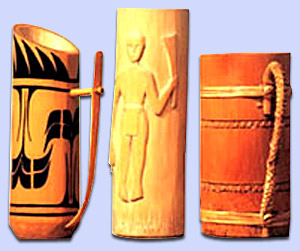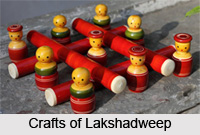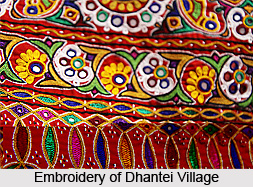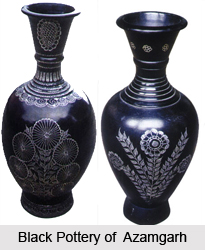 Clay Crafts of Northern India is the face of the cottage industry of the place. Clay crafts in Uttar Pradesh are well known for black pottery. Several clay crafts of Uttar Pradesh have been part of the archaeological excavations at many sites in Uttar Pradesh. Thus, these artefacts stand as the evidences of an ancient tradition. These excavations also testify that the craftsmen of those eras were deft in creating different forms from clay and used refined techniques for the craft as well. Azamgarh in Uttar Pradesh has it own status and black pottery is hugely practised in this area. The craftsmen make articles out of the light-yellow and olive coloured clay which has a very fine texture and shapes very well to different forms. The artisans of this place create a wide variety of items ranging from terracotta marathons or jars to surahis or long-necked and spouted vessels, lamps and containers, sometimes betel leaves and even ink are imparted with a lustrous black colour. After the clay mould is given a desired shape, the items are baked in fire and then are washed with a slip, powered mango bark and crude carbonate of soda. The surface is then burnished with mustard oil after which a sharp twig is used for decoration. After following these procedures, the clay wares are then set to smoke firing which gives them the black lustre. After creating the objects, the items are rubbed with oil and then baked once again. The grooves of the design are then filled in by hand with a fine silvery powder that is a mixture of lead, zinc and mercury. When the silvery powder is washed with water and polished, the clay wares exude a silvery hue against the black background of the terracotta. The craftsmen of this state create an array of black pottery items that include vases, cups and saucers, water jugs, plates, jars, and flower pots etc. Various beautiful floral and geometric designs are then itched to it.
Clay Crafts of Northern India is the face of the cottage industry of the place. Clay crafts in Uttar Pradesh are well known for black pottery. Several clay crafts of Uttar Pradesh have been part of the archaeological excavations at many sites in Uttar Pradesh. Thus, these artefacts stand as the evidences of an ancient tradition. These excavations also testify that the craftsmen of those eras were deft in creating different forms from clay and used refined techniques for the craft as well. Azamgarh in Uttar Pradesh has it own status and black pottery is hugely practised in this area. The craftsmen make articles out of the light-yellow and olive coloured clay which has a very fine texture and shapes very well to different forms. The artisans of this place create a wide variety of items ranging from terracotta marathons or jars to surahis or long-necked and spouted vessels, lamps and containers, sometimes betel leaves and even ink are imparted with a lustrous black colour. After the clay mould is given a desired shape, the items are baked in fire and then are washed with a slip, powered mango bark and crude carbonate of soda. The surface is then burnished with mustard oil after which a sharp twig is used for decoration. After following these procedures, the clay wares are then set to smoke firing which gives them the black lustre. After creating the objects, the items are rubbed with oil and then baked once again. The grooves of the design are then filled in by hand with a fine silvery powder that is a mixture of lead, zinc and mercury. When the silvery powder is washed with water and polished, the clay wares exude a silvery hue against the black background of the terracotta. The craftsmen of this state create an array of black pottery items that include vases, cups and saucers, water jugs, plates, jars, and flower pots etc. Various beautiful floral and geometric designs are then itched to it.
The clay crafts of Uttar Pradesh are also known for the Khurja pottery. This state has been remaining the centre for Khurja pottery for years. The potters involved in this craft incorporate their own skills and ideas with the distinct style of the state itself. The tradition of Khurja pottery is relatively new in comparison with other trends of pottery trends. The artisans follow the basic form and texture of the article along with their own creative excellence while making the objects. The fine blend of vibrant hues makes the Khurja pottery of Uttar Pradesh eye catching. The excellent designs, the texture of the crafted items and the choice of colours add a touch of beauty to these clay wares. The craftsmen create a special pitcher-like form which is designed with thick slip into a light relief.
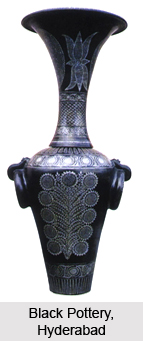
Sometimes to sport floral designs, the artisans use sky blue motifs against a white background. A special kind of water pots, which is called surahis in colloquial language, are one of the well admired pots of Uttar Pradesh, stand uniform for green-blue glazes with plain surfaces. The base of this pot is made of red clay. Chunar is also well known for creating excellent variations in clay crafts. Following the pace of modern trend, the potters use dark brown slip to render the items desired hue or the items are left chalky white coloured.
The clay crafts are prevalent in almost all parts of Uttar Pradesh including Meerut and Hapur. These zones of Uttar Pradesh are known for creating excellent water containers. They stand out with their striking designs of flowing lines and floral patterns on the containers. Chinhat in Lucknow and Mausalia are the other centres for creating admirable clay wares that include tableware and other items that are skilfully decorated with colour. Mausalia produces a special kind of clay ware with a dark lustrous body. This sheen is obtained by dipping it into a solution of clay and vegetable matter, dried, then rubbed with a vegetable oil, and then baked in fire. This process renders a lustrous effect to the vegetable matter. Silver ornamentation is done on the baked surface and later it is rubbed with mercury and tin. The use of this type of wares is however limited due to the fact that the clay wares are fragile as the clay is baked at a low temperature.
In Uttar Pradesh the clay comes from two of the local lakes. Lumpy coarse clay from one lake is mixed in equal parts with fine sandy clay from the second lake. The two clays are stored on a piece of land close to the house. The various items of clay ware which are made in Uttar Pradesh are several sizes of lidded containers, beakers, jugs, vases, incense holders, and plates which are all turned so that they have a highly regular symmetrical appearance. Ritual pots are an important part of the death ceremony and most potters keep a supply in stock. Several egg shaped containers are very common in Uttar Pradesh.
In Uttar Pradesh it is believed that at the time of Creation, Lord Brahma created Prajapatis, or the potters, and assigned them the task of making pots. Lord Vishnu gave his disc to them to serve as the wheel, Lord Shiva gave his lance to turn the wheel, and Brahma gave a string from his sacred thread by which a finished pot could be detached from the wheel. Prajapati is the male, he operates the wheel and creates; the earth is female, the substance from which Prajapati creates.
In the recent times the potters are not given many facilities in the state. Sometimes their houses lack the basic amenities of life. They use several areas of their house for working. The roof terrace is used for pot storage, the throwing area and wheel are in the courtyard, and the clay preparation area is outside the front door.
Clay crafts of Delhi are predominantly based on Blue pottery which was introduced to India from the land of Persia via Isfahan, Samarkhand, Kabul and Peshawar by the Islamic invaders. The Muslim tradition was introduced to India as different dynasties settled in different regions of India. Along with them, the artisans came and their technique of making blue pottery was introduced to the Indian artisans. The clay they used in creating the clay crafts of Delhi was predominantly blue in colour.
With the beginning of the British period in the early 17th century, the clay craft of Delhi was rechristened as `Delhi Blue.` The artisans of Blue pottery used to reside basically at Khurja, a village 100 kilometres away from Delhi. By this time, artisans of Khurja used to produce cheap, easily marketable items. The technique of Blue pottery which is the use of blue glaze on pottery made from Multani mitti (Fuller`s earth). This is basically an imported technique developed by enterprising Mongol artisans. With their own intellect, the Indian craftsmen amalgamated Chinese glazing technology with Persian decorative arts to render the craft articles an additional sheen and style. At the basic period, the Blue pottery was predominantly used in creating tiles to decorate mosques, tombs and palaces.
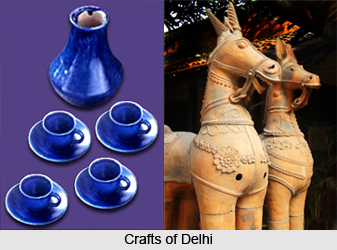
The later history of the clay crafts of Delhi depicts that the Mughals began using them in India extensively. This craftsmanship became the well known artistry in India and as a result Delhi was traced as the most important centre of this craft. In this particular craft, the Persian blue dye bestows the attractive colour. The Delhi Blue pottery has attained its identification due to the fact that the created articles were characterised by a rich glazed blue surface. The articles are beautifully painted with Mughal motifs and are accented by other colours on a clear, white base.
Clay craft centres of Himachal Pradesh are basically located in the areas like Kangra, Mandi, Kulu, Chamba, and Shimla where the communities of many migrated potters reside for decades. In Himachal Pradesh potters enjoy a relatively higher standard of living. This is because there is still a demand for earthenware vessels and there is a strong tradition of using clay figures and vessels for ritual occasions. The area of Himachal Pradesh is still rich in folklore and legends involving the potter, his wheel and his pots.
The potters, involved in the clay craft of Himachal Pradesh, are known as `kumhars` by the local people. The artisans are adept at creating clay items like pots, toys, money banks, pitchers, bowls, platters, cups, and lamps, flower vases of different shapes and sizes that are praised among the local people. These items are decorated with white patterns drawn with Golu clay. Apart from these, there are some items which are hugely used for storage purpose. The clay wares of Himachal Pradesh are found in its various forms like gidya, patri and narele etc. The figurines of Hindu gods and goddesses are made and painted in the most beautiful shades along with many accessories. These idols of various gods and goddesses are worshipped in various festivals of Himachal Pradesh.
The centre of clay craft of Himachal Pradesh is located in Kangra where the potters make clay items using black and dark red colours. The products made are mainly for domestic use and one of the famous items of this region is the container which is used for setting curds.
The beauty of mud architecture is visible everywhere in Himachal Pradesh, with vertical and horizontal planes merging together organically. Mud stairs and cupboards grow out of floors and walls inside, and outside continue to flow into courtyards. The clay crafts of the state reflect the contours and colours of the surrounding landscape and a result a complete visual harmony is achieved. Hand-cut grey slate tiles cover the roofs, also acting as drying surfaces for the buffalo dung cakes which can be seen in neat lines and rows everywhere, implanted with the finger marks of the woman who patted them into shape.
The domestic vessels of Himachal Pradesh are exquisitely decorated and are of the finest quality. The potters of the state are greatly talented but in the present age the new generation is moving away from pottery to a number of other lucrative occasions.
Work of pottery in Himachal Pradesh is seasonal and stops in the winter months of mid-November to January and during summer from mid-May to July. The clay that is used for pottery in Himachal Pradesh is both red as well as yellow clay. The clay is collected twice a year.
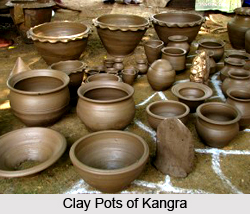 The various types of pots which are prepared in Himachal Pradesh are Gharra for containing water, Muggi for carrying water to the fields, Gharau for boiling milk - different sizes, Dhunnu for boiling milk, Tudhunu for boiling milk and buttermilk, Muggru to carry milk for sale, Kawradu and Dhialu for yoghurt, Girriya for ghee, Parru small container for general use, Katori for vegetables, Girya for pickles and ghee, Kanatu for water drained from rice then given to the animals Handi for cooking, Kangri charcoal burning heater used in the winter Hooka and Chillum for tobacco smoking Goluk money box Auli ritual pot for marriage, plus other ritual pots for death and birth.
The various types of pots which are prepared in Himachal Pradesh are Gharra for containing water, Muggi for carrying water to the fields, Gharau for boiling milk - different sizes, Dhunnu for boiling milk, Tudhunu for boiling milk and buttermilk, Muggru to carry milk for sale, Kawradu and Dhialu for yoghurt, Girriya for ghee, Parru small container for general use, Katori for vegetables, Girya for pickles and ghee, Kanatu for water drained from rice then given to the animals Handi for cooking, Kangri charcoal burning heater used in the winter Hooka and Chillum for tobacco smoking Goluk money box Auli ritual pot for marriage, plus other ritual pots for death and birth.
The art of pottery is held in high esteem in the state of Himachal Pradesh. This is very evident from the fact that on the day of Diwali (festival of lights) the wheel of the potter is decorated with a paste made from rice flour. Then a puja is performed with offerings of flowers, incense, rice and sweets.
In Himachal Pradesh still the practice of Jajmani exists. In this system potters are bound to exchange with the landowners vessels for grain. Pots made by the potters are sold in the melas. Potters in this area also work around the religious festivals when there is a demand to replace water and cooking vessels and for ceremonial clay objects. For example, clay oil lamps are bought at Diwali in November; at Holi water pots are replaced, and on Shankranti, just before the wheat harvest in April, large pots are bought by the farmers in order to offer water to their dead ancestors.



